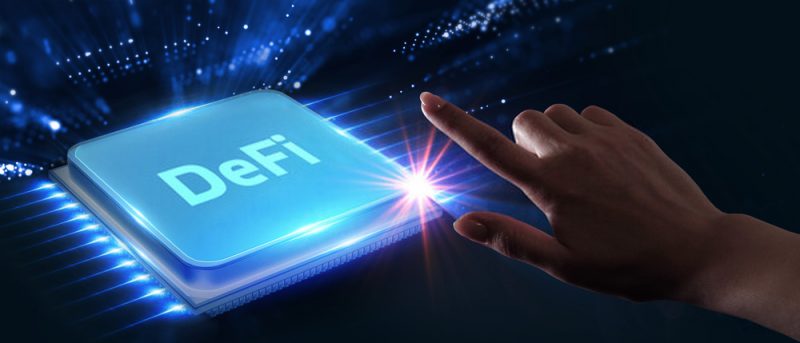Though the field of Decentralized Finance (DeFi) is still undergoing technical experimentation, the main benefit it provides is easy access to basic financial services for everyone in the world without the presence of any intermediary in the system. This will help the unbanked section of the population who have been currently left out of the mainstream economy by the traditional banking system. According to DeFi pulse, a web portal that tracks the industry closely, a whopping $14.42 billion have been locked in various DeFi projects by investors.
Some must-know facts about DeFi Open Finance Development
- It favors network effects by uniquely combining different applications ensuring high interoperability.
- It operates based on a permissionless ecosystem, supported by powerful blockchain infrastructure and distributed public ledgers.
- Ethereum is the numero uno platform for DeFi Development as it has an enthusiastic team of developers, programmatic flexibility, and advanced decentralization.
- Ethereum 2.0 will launch in the early months of 2021 which will boost the scalability and usability of Ethereum by reducing chances of network congestion, and decreasing the transaction costs which will eventually boost the adoption and growth of DeFi-based applications.
- The other platforms where DeFi projects are being actively developed are TRON, EOS, and IOST.
- DeFi needs to improve on its unintuitive user interface, non-existence of risk-adjusted pricing, and low liquidity when compared to its centralized counterparts.
- There are various projects in DeFi that includes lending and borrowing platform development, decentralized payments systems, insurance system, decentralized exchange, asset management, decentralized crypto banking, decentralized fund management, decentralized lottery system, and DeFi staking platform development.
The main advantages of DeFi Development are
- It is highly resistant to transaction censorship and permits worldwide participation regardless of social status and there is no economic or racial discrimination.
- By using the immutable blockchain network and automated smart contracts, low-cost transactions are facilitated.
- The user has full control over his funds through the private keys as DeFi projects are created in a non-custodial blockchain ecosystem.
- A high level of transparency is ensured through price efficiency, capital efficiency, the transmission of market information on a real-time basis, and minimum principal-agent risks.
- All the personal interests of the users are governed by a transparent and well-defined protocol.
- Customers can operate DeFi without even possessing a bank account or a valid credit score. Hence, using DeFi is simple, easy, and completely hassle-free.
The prime obstacles to the growth of Decentralized Finance (DeFi)
- It is suffering from insufficient liquidity in contrast to centralized trading platforms. This affects the ability to handle large trading volumes generated by the users. Hence, it becomes tough to offer services to users at very low rates as it is not economically feasible.
- Since there is no credit scoring in DeFi, this contributes to over-collateralization of products which reduces the leverage earnings for professional traders.
- Technical faults like bugs, overflows, underflows, and reentrancy attacks can wreak havoc on the daily business operations leading to false or fraudulent transactions that are irreversible on the immutable blockchain network.
- There are operational challenges too if there is a manipulation of price feeds which are known as oracles and issues in the implementation of complex governance protocols.
- Ethereum is facing some issues like network congestion, leading to market inefficiency and delays in transmission of important information to the participants, and the transactions with lower gas fees may be kept in the pending state when compared to transactions that have higher gas fees.
The various use-cases of DeFi Open Finance Development
- Borrowing and lending activities are facilitated in DeFi finance where loans can be availed by eligible debtors in cryptocurrency. Borrowers can short an asset and create leverage while lenders will earn consistent interest income. Dharma is one of the popular DeFi based lending protocols with more than 2000 different DeFi assets available on its platform. It offers a non-custodial smart wallet along with real-time tracking of a user’s crypto portfolio with more than 4 million token pairs.
- Stablecoin development is supported by various DeFi projects. It will be pegged to a fiat currency and its value remains stable without any volatility. MakerDAO has built a stablecoin named DAI which is a decentralized digital currency that gets integrated with crypto wallets, games, and different DeFi platforms. It is also used by institutions that have digital assets in their custody.
- Decentralized exchanges enable secure and private trading of different digital assets as an alternative to markets. Kyber is one of the leading decentralized exchanges in the market which allows users to exchange Ethereum tokens quickly. It has a swapping facility and also accepts limit orders. It offers integration with various crypto wallets like Trezor, MetaMask, Ledger, and Torus.
- DeFi projects are also being undertaken in the fields of derivatives, exotic assets, and prediction markets. It can be used for different purposes like risk management, betting, and leveraged trading. Augur is one of the unlimited betting platforms where one can bet on the world’s leading events, sports matches, and economics by trading in ETH and USD. It ensures users the benefits of decentralization and pseudonymity. It enables universal and transparent access to its markets with guaranteed payouts and low trading fees.
- DeFi yield farming development refers to offering crypto tokens into the liquidity pools on a DeFi ecosystem. The investor gets a percentage of the interest as his reward. It offers steady growth, a higher ROI, and reliable yields. Aave is a DeFi yield farming project that functions in the form of a non-custodial protocol to enable the creation of liquidity markets. Users can borrow assets and earn interest on their deposits. It offers both cryptocurrencies and stablecoins on its platform.
- DeFi staking platform development is another emerging business where users hold cryptocurrency for a specific period to authorize transactions and support the network. They earn passive income in the form of interest for holding their crypto coins. It offers a lot of advantages as it is easy to use, energy-efficient, users can earn transaction fees by applying the proof of stake consensus mechanism, and can also mine crypto coins and hold it in their personal wallets.
- DeFi smart contract development refers to a pre-programmed software that helps in automating the business operations through a set of well-defined terms and conditions. The benefits include 100% digitization, better security, non-interference of any external factors, elimination of third parties, improved accuracy, and higher speed.
Hence, as seen above, the Decentralized Finance (DeFi) space is booming now with a lot of innovative and exciting projects. We are currently only at the beginning of the path that will revolutionize the world of finance forever. It is open-source, stores data in the form of distributed nodes which adds an extra layer of security, and uses a trustless mechanism as it does not rely on any third parties.
It is growing very fast and will need to overcome different challenges, such as user experience and the trust of the masses. Decentralized digital assets and access to uncensored financial services will soon become the new normal.




